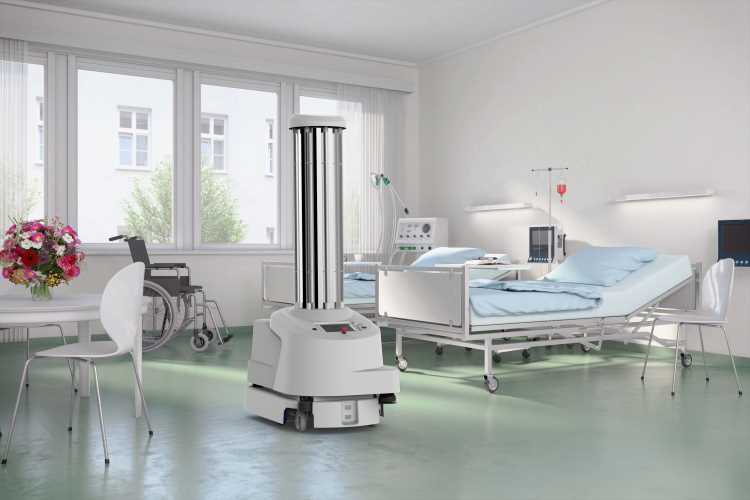
Robots play an important role in fighting the coronavirus SARS-CoV-2 around the globe. Disinfection robot UVD for example has been in high demand since the outbreak of COVID-19 pandemic. Chinese hospitals have ordered more than 2,000 UVD robots by Danish manufacturer Blue Ocean Robotics. They started to destroy viruses in Wuhan, where the global pandemic began.
The units operate in more than 40 countries – in Asia, Europe and the United States. UVD uses ultraviolet light (UV-C) to kill harmful microorganisms. The robot is the current holder of the IERA innovation award by IEEE and the International Federation of Robotics (IFR).
“We are now helping solve one of the biggest problems of our time, preventing the spread of viruses and bacteria with a robot that saves lives,” says Claus Risager, CEO of Blue Ocean Robotics. “The immediate demand has increased a lot with the outbreak of COVID-19. Existing customers buy many more units than before, and many new customers are ordering the UVD robots to fight coronavirus and other harmful microorganisms.” This is an ongoing success story for the IERA award winning robot. Blue Ocean Robotics has seen a growth in sales of more than 400 percent annually over the last two years.
Robot moves autonomously
The Danish robot moves autonomously around patient rooms and operating theatres - covering all critical surfaces with the right amount of UV-C light in order to kill specific viruses and bacteria. The more light the robot exposes to a surface, the more harmful microorganisms are destroyed. In a typical patient room, 99.99 % of all viruses and bacteria are killed within 10 minutes.
Robot helps at airports, schools or office spaces
“UVD is a supplementary device which assists the cleaning staff,” said Claus Risager. For safety reasons, it works on its own and automatically disengages the UV-C light if someone enters the room. The collaborative robot can be used in various enclosed spaces – not only in hospitals. The technology also works in environments such as office spaces, shopping malls, schools, airports and production facilities.

“UVD Robot” by Blue Ocean Robotics drives autonomously and eliminates bacteria and other harmful microorganisms in hospitals © Blue Ocean Robotics
“Robots have a great potential of supporting us in the current severe corona pandemic,” said Dr Susanne Bieller, General Secretary of the International Federation of Robotics.
“They can support us in healthcare environments, but also in the development, testing and production of medicine, vaccines and other medical devices and auxiliaries. Disinfection tasks performed e.g. by UVD units or safe distribution of hospital material in quarantine zones - without personal contact - provided e.g. by Photoneo´s mobile robot Phollower, are just two of many examples.”

Phollower 100 mobile platform © Photoneo
By now, medical robots represent a well-established service robot market with a considerable growth potential. Sales of medical robots increased by 50% to 5,100 units in 2018. This is according to the statistics published in World Robotics by IFR.
Press contact
econNEWSnetwork
Carsten Heer
Tel. +49 (0) 40 822 44 284
Email: [email protected]
Videos
Watch UVD at work: https://vimeo.com/291756170
Watch Phollower at work: https://www.youtube.com/watch?v=HIckNx_Otq0&feature=youtu.be
Phollower (developed under the working title Pathfinder ) is a new-generation autonomous mobile robot for an ultra-modern material transport and handling in warehouses, hospitals, hotels and factories. It helps the staff in hospitals and other health care centers with distribution of medicines, laundry and other material to respective workplaces. It saves a lot of time and energy, and no adjustments of premises are needed to allow the robot to move in a given space, including via elevators, without any difficulties. Carrying (max 100 kg/ 220.5 lbs) and pulling (max 350 kg/ 771.62 lbs).
Downloads
- Blue Ocean Robotics UV Desinfection Robot (147KB)
- Phollower 100 mobile platform - copyright Photoneo (69KB)
- Phollower 100 medicaments delivery - copyright Photoneo (41KB)
- IFR Pressemitteilung Roboter helfen gegen Coronaviren (134KB)
- IFR Press Release Les robots aident à lutter contre le coronavirus - French (129KB)
- IFR Press Release ロボットが世界中のコロナウイルスとの戦いを支援-Japanese (217KB)
- IFR Press Release 机器人帮助抗击全球新型冠状病毒肺炎 - Chinese (235KB)





